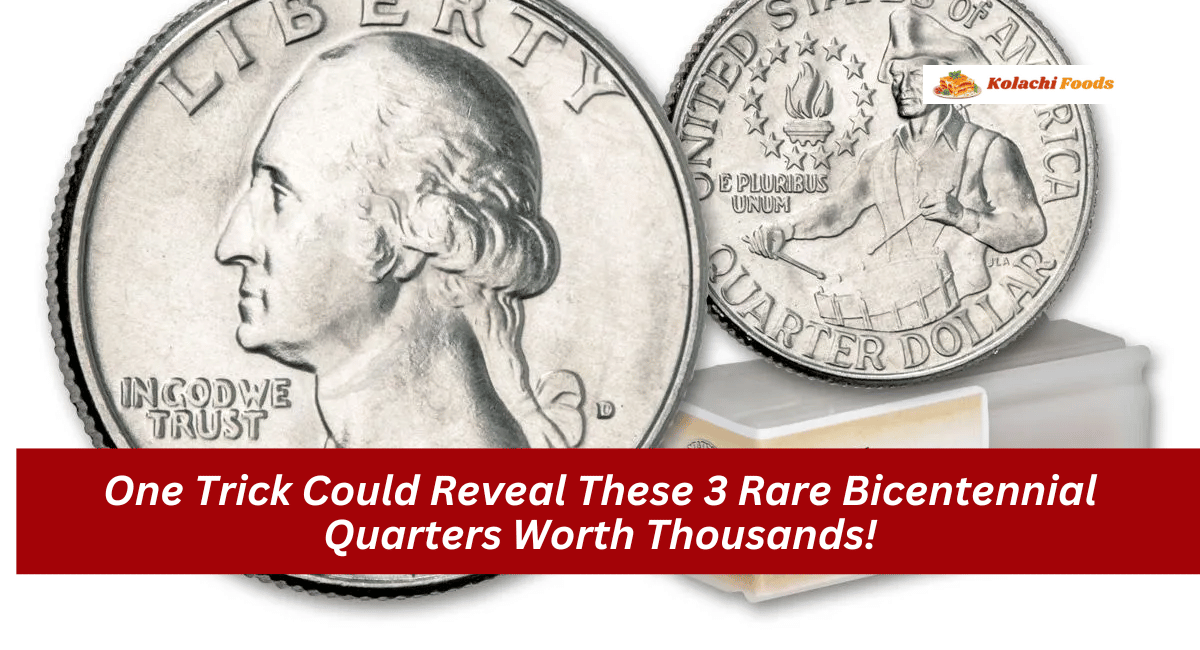The 1976 Bicentennial quarter is more than just a nostalgic piece of currency; it represents a significant milestone in American history—the nation’s 200th anniversary.
While millions of these quarters were minted, a select few are worth considerably more due to their rarity and unique features. If you’re sifting through your spare change or coin collection, this guide will help you spot three rare Bicentennial quarters that could be worth thousands!
Understanding the Bicentennial Quarter
The Bicentennial quarter features a unique design that sets it apart from standard quarters. On the reverse side, it displays a depiction of Independence Hall, surrounded by the inscriptions “Bicentennial” and “1776-1976.”
This special design commemorates America’s independence and was part of a series of coins released for the bicentennial celebration.
Why Some Quarters Are More Valuable
Most Bicentennial quarters are worth only their face value of 25 cents. However, certain variations can significantly increase a coin’s value. Understanding these distinctions can turn your casual coin search into a treasure hunt. Below are three notable Bicentennial quarters that can yield impressive returns.
| Coin Type | Description | Potential Value |
|---|---|---|
| 1976 Silver Bicentennial Quarter | Made from 40% silver, included in special collector sets. | $10 to $100 |
| 1976-D Bicentennial Quarter | Notable for minting errors like off-center strikes or double dies. | Hundreds of dollars |
| 1976 Proof Bicentennial Quarter | Features a polished, mirror-like finish and typically has an “S” mint mark. | $10 to $50 or more, especially if graded highly. |
1. The 1976 Silver Bicentennial Quarter
One of the most sought-after variants is the 1976 Silver Bicentennial quarter. Unlike the standard quarters that contain no silver, these special coins are composed of 40% silver. They were part of limited edition collector sets, making them much rarer.
Identifying the Silver Quarter
To identify a silver quarter, check for:
- Shiny Silver Edge: Look for a bright, shiny edge compared to the typical copper-nickel look of regular quarters.
- Mint Mark: These quarters typically do not have a mint mark, but if you find one that appears silver, it’s likely from the special collector sets.
Value Range
The value of a 1976 Silver Bicentennial quarter can range between $10 and $100, depending on its condition. Coins in pristine condition are naturally more desirable to collectors.
2. The 1976-D Bicentennial Quarter with Minting Errors
Another treasure to look out for is the 1976-D Bicentennial quarter, particularly if it has minting errors. Minting errors can significantly increase a coin’s value, sometimes making them worth hundreds of dollars.
Common Minting Errors
When searching for valuable 1976-D quarters, examine your coins closely for these common minting errors:
- Off-Center Strikes: This occurs when the coin is not properly aligned during the minting process, resulting in a design that appears shifted.
- Double Dies: Look for areas where the design is duplicated, creating a double image.
- Die Cracks: These cracks occur on the die used to mint the coins and can create unique and valuable features on the coin.
How to Examine Your Coins
To accurately assess potential minting errors, use a magnifying glass. Look closely at the details and edges of the coin. Any discrepancies can indicate a valuable error coin.
3. The 1976 Proof Bicentennial Quarter
The 1976 proof Bicentennial quarter is another valuable find, intended specifically for collectors. These coins are struck with specially prepared dies that create a polished, mirror-like finish.
Identifying Proof Coins
To identify a proof quarter, check for the following:
- Brilliant Finish: Proof coins have a shiny, mirror-like appearance. They typically show no signs of wear or circulation.
- Mint Mark: The proof quarter will have an “S” mint mark, indicating it was minted in San Francisco.
Value Range
The 1976 proof Bicentennial quarter can be valued between $10 and $50 or more, particularly if it is graded highly. The better the condition and the higher the grade, the more it’s worth to collectors.
Conclusion
Knowing what to look for when examining your spare change can lead to exciting discoveries. The 1976 Silver Bicentennial quarter, 1976-D quarter with minting errors, and 1976 proof quarter are just a few examples of potentially valuable coins.
By carefully inspecting your coins for these unique features, you might uncover rare treasures that could add significant value to your collection. Remember, the next time you dig through your change jar, you could be sitting on a small fortune!
FAQs
1. How can I tell if my 1976 Bicentennial quarter is silver?
Check the edge of the coin. A silver quarter will have a shiny, silver edge, while standard quarters will appear duller and have a copper-nickel composition.
2. What are the most valuable minting errors to look for on the 1976-D quarter?
Look for off-center strikes, double dies, and die cracks. These errors can significantly increase the value of your coin.
3. How do I know if I have a proof coin?
Proof coins have a mirror-like finish and usually show no signs of wear. They also have an “S” mint mark on the reverse side.
4. Where can I get my rare quarters appraised?
You can take your coins to a reputable coin dealer, attend a coin show, or consult with a certified numismatist for an appraisal.
5. Are all Bicentennial quarters valuable?
Most Bicentennial quarters are worth only their face value of 25 cents. However, specific variants, like the silver quarter, coins with minting errors, and proof coins, can be worth significantly more.
With this knowledge in hand, you’re now ready to embark on your coin-hunting adventure! Keep your eyes peeled, and happy treasure hunting!
READ MORE: This $120 Million Bicentennial Quarter Will Change Your Life

